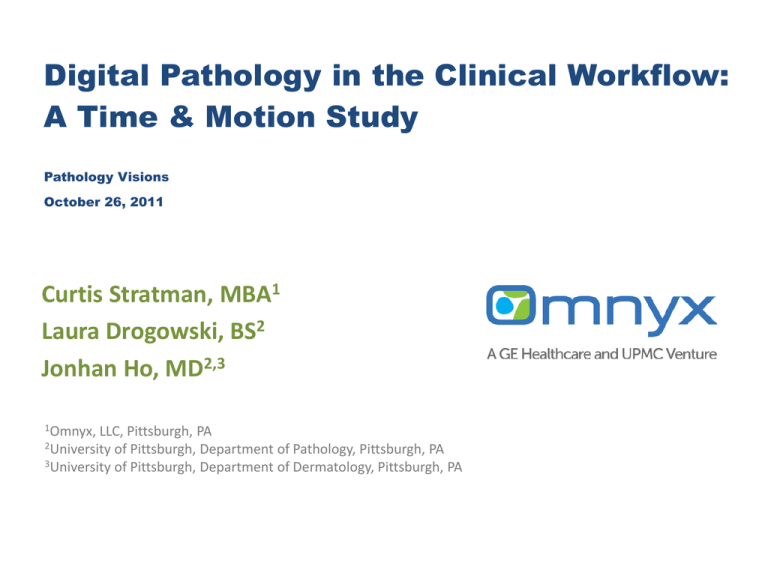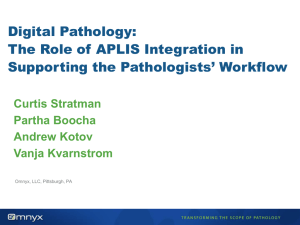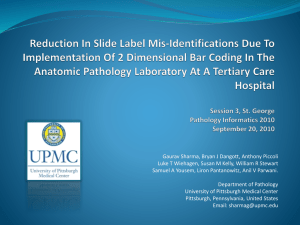View PPT slides - Digital Pathology Association
advertisement

Digital Pathology in the Clinical Workflow: A Time & Motion Study Pathology Visions October 26, 2011 Curtis Stratman, MBA1 Laura Drogowski, BS2 Jonhan Ho, MD2,3 1Omnyx, LLC, Pittsburgh, PA of Pittsburgh, Department of Pathology, Pittsburgh, PA 3University of Pittsburgh, Department of Dermatology, Pittsburgh, PA 2University Disclosures Stratman – Employee of Omnyx Ho – Research Grant from Omnyx Goal of the Studies How would the migration to an all-digital workflow impact staffing across an organization, including both pathologists and the histology lab? Understanding this impact is significant for evaluating digital pathology solutions for high-volume uses. 3 HISTOLOGY LAB TIME AND MOTION STUDY Histology Lab T&M Study Context Physical Workflow Accessioning / Grossing / Histology Case Assembly Quality Check Pathologist Slide Creation Transport Enter Patient Enter Case Enter Slides Case Entry Stain and coverslip slides Imaging Sort slides to Cases Case Assembly Review slide quality Review case quality Quality Check Pathologist 0 Enter Patient Enter Case Enter Slides Load slides Generate images Unload slides Sort images to cases Review slide quality Review image quality Review case quality Histology Lab T&M Study Context Digital Workflow – Standalone Imaging Solution Accessioning / Grossing / Histology Case Assembly Quality Check Pathologist Slide Creation Transport Enter Patient Enter Case Enter Slides Case Entry Stain and coverslip slides Imaging Sort slides to Cases Case Assembly Review slide quality Review case quality Quality Check Pathologist 0 Enter Patient Enter Case Enter Slides Load slides Generate images Unload slides Sort images to cases Review slide quality Review image quality Review case quality Histology Lab T&M Study Context Digital Workflow – Standalone Imaging Solution Accessioning / Grossing / Histology Case Assembly Quality Check Pathologist Slide Creation Transport Enter Patient Enter Case Enter Slides Case Entry Stain and coverslip slides Imaging Sort slides to Cases Case Assembly Review slide quality Review case quality Quality Check Pathologist 0 Enter Patient Enter Case Enter Slides DUP TASKS Load slides Generate images Unload slides NEW TASKS Sort images to cases Review slide quality Review image quality Review case quality EQUIVALENT TASKS Histology Lab T&M Study Context Digital Workflow – APLIS Integrated Accessioning / Grossing / Histology Case Assembly Quality Check Pathologist Slide Creation Transport Enter Patient Enter Case Enter Slides Case Entry Stain and coverslip slides Imaging Sort slides to Cases Case Assembly Review slide quality Review case quality Quality Check 0 Eliminate Enter Patient Enter Case Enter Slides DUP TASKS Pathologist Load slides Generate images Unload slides NEW TASKS Sort images to cases Review slide quality Review image quality Review case quality EQUIVALENT TASKS Histology Lab T&M Study Context Digital Workflow – APLIS & Barcode Integrated Accessioning / Grossing / Histology Case Assembly Quality Check Pathologist Slide Creation Transport Enter Patient Enter Case Enter Slides Case Entry Stain and coverslip slides Imaging Eliminate Enter Patient Enter Case Enter Slides DUP TASKS Sort slides to Cases Case Assembly Review slide quality Review case quality Quality Check 0 Eliminate Load slides Generate images Unload slides NEW TASKS Sort images to cases Pathologist Review slide quality Review image quality Review case quality EQUIVALENT TASKS Histology Lab T&M Study Goals Standalone APLIS Integrated APLIS & Barcode Integrated Case Entry + Tasks Imaging - Tasks Imaging Imaging Case Assembly Study Case Entry time to: • understand incremental staff costs for standalone implementation • quantify value of APLIS interface Study Case Assembly time to: • understand opportunity to offset increment staff costs from imaging • quantify value of barcoding interface Histology Lab T&M Study Methodology Case Entry Time 1. 2. 3. Entered 17 randomly selected cases into Omnyx application Recorded time to enter Patient, Case, and Histology information Performed regression to model component times Data Component Average Time (Each) Patient & Case 68 seconds Histology Part(s) 25 seconds Histology Slide(s) 3 seconds Average Case (1 Part, 10 Slides) Support Average Pathologist (3500 cases / year) Average Lab FTE (2000 hrs / year) = 2:03 minutes / case = 119.6 hours / year = 6.0% FTE / pathologist = ~1 FTE / 16 pathologists Histology Lab T&M Study Summary Standalone APLIS Integrated APLIS & Barcode Integrated Case Entry 6.0% FTE/Path + Tasks Imaging (TBD) Imaging (TBD) - Tasks Imaging (TBD) Case Assembly 18.5% FTE/Lab Analyzing total impact requires additional study of actual time for imaging tasks • Highly variable with scanner design APLIS Integration avoids actual incremental 6% lab FTE per pathologist APLIS + Barcode Integration potentially reduces 18.5% lab FTE to offset some of the incremental time required by imaging tasks Histology Lab T&M Study Methodology Case Assembly Time 1. 2. 3. Observed histology lab for entire shift Recorded time to spent on tasks between coverslipping and courier Extracted time spent on Case Assembly tasks: • • Sorting and matching slides to cases Sorting and matching cases to pathologists or services Academic Center Labs Number of Labs Observed 4 Number of Total Observations 8 (days) Range of Case Assembly Time 0:57:20 – 1:53:46 Average of Case Assembly Time / Day 1:29:16 Average Lab FTE (8 hours / day) = 18.5% FTE PATHOLOGIST TIME AND MOTION STUDY Pathologist T&M Study Context Experience from Radiology Radiology realized significant improvements in productivity as the most significant value-add from PACS implementation. “Since the introduction of PACS, reporting times have decreased by 25% and the productivity improved by 18%.” Mackinnon AD, Billington RA, Adam EJ, et al. Picture archiving and communication systems lead to sustained improvements in reporting times and productivity: results of a 5-year audit. Clinical Radiology 2008; 63; 796-804. “…overall Radiology Department productivity increased by 12%, TAT improved by more than 60%. Timelier patient care resulted in decreased lengths of stay.... A well-planned PACS deployment simplifies imaging workflow and improves patient care throughout the hospital while delivering substantial financial benefits.” Nitrosi A, Borasi G, Nicoli F, et al. A filmless radiology department in a full digital regional hospital: quantitative evaluation of the increased quality and efficiency. Journal of Digital Imaging 2007; 20(2); 140-148. 15 Pathologist T&M Study Context Similarity of Pathology and Radiology The challenges pathologist experience from managing slides is similar to the challenges radiologists experienced with film. 16 Pathologist T&M Study Goal Hypothesis: Inefficiencies exist in the pathologists’ workflow that can be improved by an all digital workflow. A before-and-after study of actual impact in pathology is in-progress, therefore the first study goal was to identify the potential opportunity. 17 Pathologist T&M Study Methodology 1. 2. 3. 4. 5. Observe pathologists across multiple days, subspecialties, and sites Record time spent on each discrete task Bucket the tasks into common activities Identify the buckets impacted by an all digital workflow Calculate opportunity as a percentage of total time spent on cases Subspecialty Pathologists in Academic Setting Number of Pathologists Observed 6 Number of Total Observations 12 (days) Average Time on Case Work / Day 5:22:44 NOTE: Results varied significantly across observations, both across and within pathologists. 18 Pathologist T&M Study Results Identified Opportunities for Time Savings Matching: Organizing Cases: • • • • • • • • Matching paperwork to case Matching new stains ordered upon arrival Tracking receipt of ordered slides Re-checking slide to case match Reduced Error Correction: • • • • Transporting case to correct pathologist Obtaining correct or missing paperwork Reducing duplicate slides ordered Picking up wrong slides / missing slides Retrieving Prior Cases: • • • Sending request for prior case Context switch away from current case Tracking receipt of requested prior cases Transporting Cases: • • Giving for Pre-Signout Q/A Packaging cases for consult Prioritizing cases for review Dividing with residents and fellows Tracking which cases are ready for review Tracking cases for conferences Querying for Cases: • • • • Checking mailbox for new cases Checking if STAT cases have arrived Checking if Frozen Section cases are ready Visibility of overdue cases Searching for Cases: • • • • Searching for cases when receiving phone call Searching for “orphan” slides Pulling cases for re-review at final sign-out Passing cases between residents and fellows Communication: • Sending ROI images vs. co-scheduling time at scope 19 Pathologist T&M Study Results Breakdown of Time Working Cases Other 16.0% (0:51:43) Slide Review 36.0% (1:56:13) Workflow Opportunities 13.4% (0:43:09) Reporting 34.6% (1:51:38) Pathologist T&M Study Results Breakdown of Workflow Opportunities Workflow Opportunities Other 16.0% (0:51:43) Slide Review 36.0% (1:56:13) 13.4% Organizing Cases 24.1% (0:10:25) Querying for Cases 18.5% (0:07:59) Waiting for Delivery 11.2% (0:04:49) Matching 10.5% (0:04:32) Searching for Cases 9.4% (0:04:04) Transporting Cases 9.2% (0:03:58) Other Reporting 34.6% (1:51:38) 17.0% (0:07:21) 100% (0:43:09) Pathologist T&M Study Results Additional Opportunities for Time Savings Common current uses: • • • Tumor boards Frozen sections Consultations Secondary effects caused by delays from noted opportunities: • • Time re-orienting to case after waiting for prior case Phone-tag with ordering clinician after retrieving case Level-loading work: • • Continuous flow of cases from lab to pathologist Distribute workload across locations Surrounding personnel: • • • • Resident matching Administrator preparing cases Prior case retrieval and re-storage Slide transportation (observed 1:26:11) (observed 1:35:43) Pathologist T&M Study Summary 13.4% opportunity for increase in available pathologists’ time from Workflow is a significant value-add opportunity for implementing digital pathology in routine use Example options for utilizing this time: • Increase volumes without additional staff • Increase utilization of patient history • Increase rate of quality assurance review • Improve recruiting and retention Impact of secondary effects has opportunity to show significant additional opportunity Reducing dependence on surrounding personnel drives efficiency across department Scoped for analysis in before-and-after study Additional analysis of Slide Review efficiency opportunities is suggested from radiology “Time-motion analysis showed a reduction of 16.2% in the overall time required for soft-copy interpretation of CT compared with that of film.” Reiner BI, Siegel EL, Hooper FJ, et al. Radiologists’ Productivity in the Interpretation of CT Scans: A Comparison of PACS with Conventional Film. AJR 2001; 176; 861-864. T&M Study Conclusions Routine use of an all-digital workflow shows… Opportunity to increase available pathologist time from workflow savings Observed average 13.4% per pathologist in addition to savings from secondary effects, frozen sections, tumor boards, consults, slide review • Quality, Profitability, Lifestyle Opportunity to eliminate case assembly tasks in the lab Observed average 18.5% FTE per lab • Offset some of the additional time required for new Imaging tasks Efficiency of pathology department has downstream effects Clinician Efficiency and Patient Care • Patient satisfaction, timely treatment, reduced length of stay Contact curtis.stratman@omnyx.com









